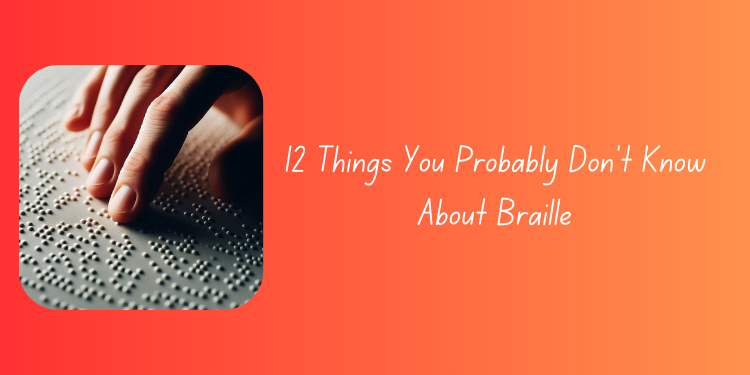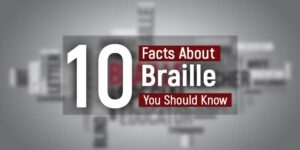We are familiar with the Braille buttons in many public areas, such as vehicles and elevator panels, but were you aware that there are two variations of it, and they can represent any language virtually in written form?
Braille stands as the foremost tactile method for learning and writing globally. Created by Louis Braille, this method employs some raised dot arrangements to represent alphabets, numbers and punctuation. Since its invention, individuals with visual impairments peruse braille with their fingertips and transcribe it using tools such as the Perkins Brailler.
However, the significance of braille is not limited to reading and writing but extends beyond that. In this blog post, we will discuss 12 factors you don’t know about braille.
1. Where was the Braille used for the first time?
Originating as a military communication method known as night writing, braille emerged in 1819 from the ingenuity of the French army. During that time, the system facilitated the communication between the soldiers during nocturnal operations, devoid of spoken words or flickering candles.
Louis Braille, a young student during that time, learned this ‘night writing’ method, and later, he invented the code “Braille.” This invention passed through many refinery phrases, and as a result, the modern braille alphabet was crafted.
2. Facts about Louis Braille
Through the efforts of Louis Braille, Braille transcended the barriers of military code language and established itself as an invaluable tool for visually impaired people. It also helped them to enable access to written language with significant efficiency and independence.
In 1999, NASA’s Deep Space 1 spacecraft traversed near an asteroid en route to capture images of the Borrelly comet. To pay homage to Louis Braille, the inventor of the tactile writing system for the visually impaired, NASA designated the asteroid as “9969 Braille.”
3. Takes more space
Braille, being a tactile method, requires more space allocation compared to the conventional alphabet. This factor leads to a larger number of braille publications. As an example, the famous fictional storybook “Harry Potter and the Goblet of Fire” spans 10 braille volumes in braille. Also, the new american bible has 45 volumes in braille.
4. Braille in different languages
Braille is a tactile representation of languages, not a language in and of itself, despite what the general public may think.
Subsequently, Braille exists in different language forms by adapting specific characters of that language and also the accent. This factor ensures that visually impaired people of any language can access education in Braille.
5. Braille Challenge
Every year, the braille institutes of Canada and the US orchestrate a contest for visually impaired students, drawing over 1400 participants to showcase their proficiency in Braille. The event features various challenges, including reading comprehension, proofreading, and spelling. Victors in different age brackets earn cash rewards alongside the esteemed recognition of their Braille mastery, reigning as champions for a full year.
6. Two versions of Braille
Braille has two major types – Grade 1, or uncontracted braille, and Grade 2, or contracted braille. While uncontracted Braille shows each letter individually, contracted Braille uses contractions and abbreviations to shorten words and phrases.
So, contracted braille is a shortened form similar to how “can’t” represents “can not .”Typically, children first grasp uncontracted braille before advancing to its contracted counterpart.
7. Braille also has math.
Being visually impaired doesn’t exempt you from learning mathematics. The Nemeth code, which Dr. Abraham Nemeth developed, helps in providing a specialized braille system that contains mathematical concepts.
Various mathematical expressions like algebraic equations and calculus derivatives are included in this code. This code provides the freedom to be engaged with and comprehend mathematical principles effectively.
8. Is Braille Capitalized?
The capitalization of “Braille” is a matter of stylistic preference. Some sources capitalize it as a proper noun, while others use lowercase as a common noun.
9. Is Braille Universal?
While Braille itself is not universal, its principles are widely adapted to various languages and alphabets, making it a vital tool for accessibility across cultures.
10. Words in Braille
In Braille, each word is represented by a combination of raised dots arranged in a specific pattern, allowing blind and visually impaired individuals to read and write effectively.
11. Fingers Of Some Braille Reader Can Fly
The fingers of a braille reader can read words faster, even than a normal book reader. A sighted person can read approximately 300 words per minute, whereas a fast braille reader can read up to 400 words per minute. The factor is they use both of their hands while reading and apply a light touch on the keys.
12. Children’s toys also feature braille
Nowadays, some children’s toys also feature braille codes. Many toy manufacturers have designed strides to ensure that all children have equal access to play some of their favorite games like Braille Uno and Braille LEGO. Lastly, Braille is not limited to reading and writing. It has also spread its wings in learning and playing music. Braille music and more open the doors for visually impaired people to learn music.
You Can Also Read Our Other Blogs
- Top 10 Fascinating Facts About Braille
- Breaking Down Barriers: Is Braille Hard to Learn?
- 4 Ways Learning Braille Can Be Fun and Games
- The Creativity in Braille: Art for the Visually Impaired
- The Importance of Braille in Today’s World
- The Impact of Braille Menus in Restaurants
- The History of Braille
- Contracted (Grade 2) Braille Explained







